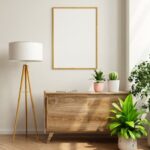Are you looking to add a breath of fresh air to your home decor? Learn how to decorate your home with indoor plants and reap the benefits of improved air quality, reduced stress, and enhanced aesthetics.
Indoor plants not only add a touch of greenery to your living spaces but also contribute to a healthier and more visually appealing environment. In this article, we will explore the various ways in which you can incorporate indoor plants into your home decor, from selecting the right plants for your space to creative display ideas and DIY plant projects.
Indoor plants have become increasingly popular as people seek ways to bring nature indoors and create a soothing atmosphere in their homes. Beyond their visual appeal, these living organisms offer numerous benefits that go beyond just adding a pop of color to your living room or kitchen.
Research has shown that indoor plants can improve air quality by removing toxins and producing oxygen, while also promoting relaxation and reducing stress levels. Whether you are a plant enthusiast or new to the world of indoor gardening, there are endless possibilities for incorporating these green companions into your home’s interior design.
When it comes to decorating with indoor plants, there are various factors to consider, such as finding the right plants for your space based on natural light conditions, choosing appropriate care and maintenance practices, and integrating them harmoniously with your existing decor. With the right guidance and inspiration, you can transform any room in your home into a lush oasis that brings joy and vitality into your daily life.
So let’s dive in and explore how you can adorn your living spaces with the beauty of nature through the art of indoor plant decoration.
Selecting the Right Plants for Your Space
Selecting the right indoor plants for your living space is essential for ensuring their health and vitality. When choosing which plants to bring into your home, there are several factors to consider.
Amount of Natural Light
One of the most important considerations when selecting indoor plants is the amount of natural light available in the space where they will be placed. Some plants thrive in bright, direct sunlight, while others prefer low or indirect light.
Assess the lighting conditions of the room and choose plants that are well-suited to those conditions. For example, a sunny window sill might be perfect for sun-loving succulents, while a dimly lit corner may be better suited for low-light varieties such as snake plants or peace lilies.
Size of the Space
The size of your living space will also play a role in determining which indoor plants are suitable. If you have limited floor space, consider hanging planters or wall-mounted containers to maximize greenery without sacrificing square footage. Conversely, if you have a large open area, consider incorporating larger plants such as fiddle leaf figs or rubber trees to make a statement and fill out the space.
Personal Taste
Finally, personal taste should also guide your selection of indoor plants. Consider your own aesthetic preferences and how different types of foliage and blooms might complement your home decor. If you favor a more minimalist look, opt for sleek and modern planters with simple, elegant greenery such as spider plants or pothos vines.
On the other hand, if you prefer a lush and eclectic style, mix and match various plant textures and colors to create an eye-catching display. Ultimately, choosing indoor plants that resonate with your personal style will ensure that they enhance rather than detract from your living space.
Understanding the Care and Maintenance of Indoor Plants
Indoor plants can bring life and color into your home, but it’s essential to understand how to care for them properly to ensure they thrive. Here are some tips and tricks for keeping your indoor plants healthy and vibrant:
- Watering: Different plants have different watering needs, so it’s essential to research the specific requirements of each plant you own. Factors such as the size of the pot, humidity level, and season can also affect how often you need to water your plants.
- Soil types: The type of soil you use for your indoor plants is crucial to their overall health. Some plants prefer well-draining soil, while others need a more moisture-retentive mix. Understanding the soil needs of your plants can make a significant difference in their growth.
- Pruning: Regular pruning is an essential part of indoor plant care, as it helps promote new growth and keeps your plants looking tidy. By removing dead or yellowing leaves and trimming back overgrown stems, you can help your plants stay healthy and vibrant.
With these care tips in mind, you can ensure that your indoor plants stay happy and flourishing in your home.
Remember that proper care isn’t one-size-fits-all; understanding the individual needs of each plant is crucial for maintaining a thriving indoor garden. By learning about the specific requirements of your plants, you can create an environment that fosters healthy growth and greenery throughout your living space.
Creative Ways to Display Indoor Plants
Incorporating indoor plants into your home decor can bring a touch of nature and freshness to any space. However, finding creative and visually appealing ways to display them can make a significant difference in the overall look and feel of your home. There are several innovative ideas for showcasing indoor plants that go beyond traditional potted plant arrangements.
One popular way to display indoor plants is through the use of hanging planters. These can be suspended from the ceiling, creating an eye-catching focal point in any room. Macrame plant hangers are another stylish option for adding greenery to your home while also incorporating a bohemian aesthetic. Additionally, tiered stands or shelving units provide an opportunity to create dynamic arrangements by grouping plants of varying heights and sizes together.
If you’re looking for a more eclectic display, consider using unique containers such as vintage teapots, glass terrariums, or repurposed mason jars as plant holders. This adds character and personality to your indoor garden while also making a statement in your home decor.
Another creative way to showcase indoor plants is by incorporating them into wall art or living walls. These vertical gardens add a modern and artistic element to any room while maximizing space and bringing nature indoors.
Overall, there are numerous creative ways to display indoor plants that cater to various design styles and personal preferences. By exploring different options, you can find the perfect method for integrating greenery into your home decor while adding visual interest and depth.
| Creative Plant Display Ideas | Description |
|---|---|
| Hanging Planters | Suspended from the ceiling for an eye-catching focal point. |
| Macrame Plant Hangers | Adds a bohemian aesthetic and style to plant displays. |
| Tiered Stands/Shelving Units | Allows for dynamic arrangements with varying heights and sizes of plants. |
Incorporating Plants Into Different Rooms
Living Room
When it comes to adding indoor plants to your living room, consider incorporating statement plants like fiddle leaf figs or large snake plants in a corner to create a focal point. You can also place smaller potted plants on side tables or use a plant stand to display multiple plants at different heights. Hanging plants like pothos or spider plants can also add visual interest and fill empty wall space.
Bedroom
Bringing greenery into the bedroom can create a calm and relaxing atmosphere. Consider placing low-maintenance plants like peace lilies or succulents on bedside tables, dressers, or shelves. Hanging planters with trailing ivy or string-of-pearls can add a touch of elegance and whimsy to the space.
Kitchen and Bathroom
In rooms that tend to have higher humidity levels, such as the kitchen and bathroom, opt for moisture-loving plants like ferns, orchids, or air plants. Utilize windowsills for small herb gardens or place pots of fresh herbs on open shelving for easy access while cooking. In the bathroom, consider adding a touch of greenery with small potted flowers or compact foliage plants that thrive in low light conditions.
By strategically placing indoor plants throughout your home, you can not only enhance the aesthetic appeal of each room but also enjoy the numerous health benefits they provide.
DIY Plant Projects
Adding a personal touch to your home decor with do-it-yourself plant projects can be a fun and rewarding experience. Not only does it allow you to express your creativity, but it also gives you the opportunity to customize your greenery to perfectly suit your space. One popular DIY plant project is creating terrariums, which are miniature gardens enclosed in glass containers. Terrariums are low-maintenance and can add a touch of nature to any room.
Another engaging DIY plant project is making your own plant stands. Whether you opt for a simple wooden design or get more elaborate with macrame hangers, having handmade plant stands can elevate the visual appeal of your indoor plants and contribute to the overall aesthetic of your home. Additionally, creating propagation stations is a trendy DIY project that not only serves as functional decor but also allows you to expand your plant collection by cultivating new ones from cuttings.
For those who enjoy crafting, these projects provide an opportunity to channel their artistic energy into something that will enhance their living environment. With just a few supplies and some imagination, anyone can create beautiful and unique pieces that showcase their love for plants and nature.
| DIY Plant Project | Description |
|---|---|
| Terrariums | Miniature gardens enclosed in glass containers; low-maintenance and visually appealing. |
| Plant Stands | Handmade stands in various designs; can elevate the visual appeal of indoor plants. |
| Propagation Stations | Functional decor crafted for cultivating new plants from cuttings; allows expansion of plant collection. |
Mixing Plants With Other Decor Elements
When it comes to decorating with indoor plants, it’s essential to consider how these green elements will blend with the other decorative elements in your home. Ensuring that your plants seamlessly integrate with your furniture, artwork, and other decor will help create a cohesive and visually appealing space. Here are some tips for mixing plants with other decor elements:
- Coordinate plant pots with your decor: Choose plant pots or containers that complement the color scheme and style of your existing decor. For example, if you have a minimalist aesthetic, opt for simple and sleek planters in neutral tones.
- Use plants as focal points: Incorporate larger plants as focal points in a room to draw attention and add visual interest. Place them strategically next to a piece of furniture or in an empty corner to fill the space.
- Balance the visual weight: Consider the visual weight of your plants and make sure they are evenly distributed throughout the room. Balance larger plants with smaller ones to create harmony in the space.
By taking into account how indoor plants interact with other decorative elements, you can elevate the overall look and feel of your home while enjoying the numerous benefits of having greenery indoors. Whether you’re aiming for a cozy bohemian vibe or a modern minimalist aesthetic, incorporating plants into your decor can enhance the ambiance and create a welcoming environment for all who enter your home.
Tips for Keeping Indoor Plants Pest and Disease-Free
Indoor plants not only bring aesthetic value to your home but also contribute to better air quality and stress reduction. However, just like outdoor plants, indoor plants are susceptible to pests and diseases that can compromise their health. Therefore, it is essential to be proactive in preventing and treating these issues to keep your indoor plants thriving.
One of the best ways to prevent pest infestations and diseases in indoor plants is by maintaining a clean and healthy environment. Regularly dusting the leaves of your plants, removing dead foliage, and keeping the surrounding area free from debris can help deter pests and reduce the risk of diseases. Additionally, proper watering practices, adequate sunlight exposure, and using high-quality soil can help strengthen the overall health of your indoor plants, making them less susceptible to infestations.
In the unfortunate event that your indoor plants do become affected by pests or diseases, it is crucial to address the issue promptly. Researching common symptoms and identifying the specific problem affecting your plant can help you determine a suitable course of action.
Depending on the issue at hand, treatment options may include natural remedies, insecticidal soaps, or professional intervention. Regularly inspecting your indoor plants for signs of trouble can help prevent minor problems from escalating into major issues that are more challenging to resolve.
By diligently implementing preventative measures and promptly addressing any pest or disease issues that arise, you can ensure that your indoor plants remain healthy and vibrant. With proper care and attention, you can enjoy the many benefits of decorating your home with lush greenery while keeping common plant problems at bay.
Conclusion
In conclusion, incorporating indoor plants into your home decor is not only a visually appealing choice but also a beneficial one. From improving air quality to reducing stress and enhancing the overall aesthetic of your living space, indoor plants offer numerous advantages. By carefully selecting the right plants for your space, understanding their care and maintenance, creatively displaying them, and integrating them with other decor elements, you can create a harmonious and inviting atmosphere in your home.
As you embrace the greenery in your home, remember that each room offers different opportunities for incorporating indoor plants. Whether it’s adding a touch of tranquility to the bedroom or bringing life to the kitchen or bathroom, there are endless possibilities for incorporating greenery throughout your living spaces. Additionally, engaging in DIY plant projects can be a fun and rewarding way to personalize your decor while providing a thriving environment for your plants.
Ultimately, by taking the time to select appropriate plants for each space, understanding their specific care needs, and integrating them seamlessly into your decor scheme, you can create a home that not only looks beautiful but also promotes a sense of well-being and harmony. So go ahead and bring more greenery into your home – you’ll be amazed at how it transforms the look and feel of your living space.
Frequently Asked Questions
How Do I Incorporate Plants Into My Home Decor?
Incorporating plants into your home decor can be a great way to add natural elements and a touch of greenery to your living space. You can start by choosing a variety of indoor plants in different sizes and shapes, and place them strategically in various areas of your home, such as on shelves, tables, or hanging from the ceiling.
You can also consider using stylish planters or pots that complement your existing decor to enhance the overall aesthetic.
How Should I Arrange My Living Room With Plants?
Arranging your living room with plants can help create a more inviting and warm atmosphere. When placing plants in your living room, consider the layout of the space and ensure that they are distributed evenly throughout the room.
You can place larger plants in empty corners or next to furniture pieces, while smaller plants can be grouped together on coffee tables or sideboards. It’s important to also consider the lighting requirements of each plant when arranging them in your living room.
Do Plants Make Your House Look Better?
Yes, plants have the ability to make your house look better by adding color, texture, and life to the space. They not only enhance the visual appeal of your home but also contribute to a cleaner and healthier indoor environment by purifying the air and reducing pollutants.
Additionally, incorporating plants into your decor can create a sense of tranquility and well-being, making your house feel more peaceful and rejuvenating. Overall, plants are a natural and effective way to elevate the appearance of your home.

I’m thrilled to be your companion on this exciting journey through the world of home decor and design. With a passion for turning houses into homes and a keen eye for the finer details, I’m here to help you transform your living spaces into beautiful, functional, and meaningful havens.





